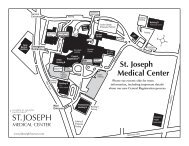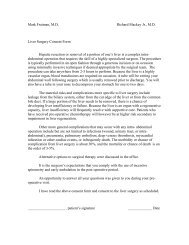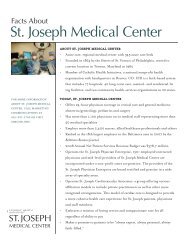Whipple Procedure Consent Form
Whipple Procedure Consent Form
Whipple Procedure Consent Form
Create successful ePaper yourself
Turn your PDF publications into a flip-book with our unique Google optimized e-Paper software.
Mark Fraiman, M.D.<br />
Richard Mackey Jr., M.D.<br />
Pancreatic Surgery <strong>Consent</strong> <strong>Form</strong><br />
The whipple procedure is a complex intra-abdominal operation that requires the<br />
expertise of a specialty-trained hepato-biliary and pancreatic surgeon. The operation<br />
involves removal of the head of the pancreas, gallbladder, and duodenum. The<br />
reconstruction involves creating a new communication between the stomach, bile duct<br />
and pancreas. The procedure typically takes 3-5 hours to perform. Occasionally a portion<br />
of the superior mesenteric vein or portal vein may need to be removed with the specimen.<br />
If this occurs, you will also have an incision in your leg to harvest a portion of either your<br />
saphenous or superficial femoral vein to repair the portal vein.<br />
After surgery you will have two tubes in your nose, one to decompress your<br />
stomach and one to feed you. You will also have a drain exiting your abdominal wall.<br />
The majority of times, all tubes will be removed prior to discharge.<br />
The more common material risks and complications related to the whipple<br />
procedure are leakage from the pancreaticobiliary anastomosis (15%) or delayed gastric<br />
emptying (30%). Some patients may experience either one or both of these complications<br />
that do not resolve prior to your discharge. In these situations, you may be discharged<br />
from the hospital with the tube in your side as well as the tube in your nose for a period<br />
of 4 to 6 weeks. If you are having a distal pancreatectomy, there is no gastric or biliary<br />
anastomosis, however the incidence of pancreatic fistula and delayed gastric emptying<br />
are similar to that of the whipple procedure.<br />
Other more general complications that may occur with any intra-abdominal<br />
operation include but are not limited to infections (wound, urinary tract or intraabdominal),<br />
pneumonia, pulmonary embolism, deep venous thrombosis, myocardial<br />
infarction, or other cardiac events or very infrequently death. The morbidity or chance or<br />
having any complication from the whipple procedure is as high as 40% and the mortality<br />
or chance of death from the procedure is around 2%.<br />
Alternative options to surgical treatment were discussed in the office.<br />
It is the surgeon’s expectations that you comply with the use of incentive<br />
spirometry and early ambulation in the post-operative period.<br />
An opportunity to answer all your questions was given to you during your preoperative<br />
office visit.<br />
I have read the above consent form and consent to the pancreatic surgery as<br />
scheduled.
_______________________ patient’s signature __________ date<br />
________________________ witness’ signature<br />
__________ date<br />
________________________ surgeon’s signature<br />
___________ date
















